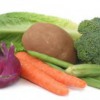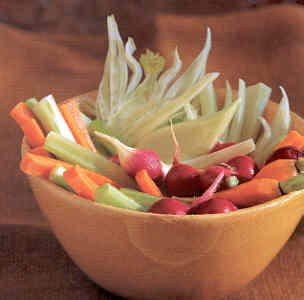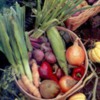More benefits from veggies and fruit.
http://www.5aday.com/html/colorway/colorway_home.phpEating 5 or more servings of colorful fruits and vegetables a day is part of an important plan for healthier living. That’s because deeply hued fruits and vegetables provide the wide range of vitamins, minerals, fiber, and phytochemicals your body needs to maintain good health and energy levels, protect against the effects of aging, and reduce the risk of cancer and heart disease.*
* Diets rich in fruits and vegetables may reduce the risk of some types of cancer and other chronic diseases.
Choose the Colors of Health
It’s all about color – blue/purple, green, white, yellow/orange, and red – and the power of colorful fruits and vegetables to promote good health. So when you're grocery shopping, planning your meals or dining out, think color.
And for variety, make it 5 A Day The Color Way:
BLUE/PURPLE
Boost the level of BLUE/PURPLE in your low-fat diet to help maintain:
• A lower risk of some
cancers*
• Urinary tract health
• Memory function
• Healthy aging
Beat the Effects of Aging
Blue/purple fruits and vegetables contain varying amounts of health-promoting phytochemicals such as anthocyanins and phenolics, currently being studied for their antioxidant and anti-aging benefits. Get blue/purple every day with foods such as:
Blackberries
Blueberries
Black currants
Dried plums
Elderberries
Purple figs
Purple grapes
Plums
Raisins
Purple asparagus
Purple cabbage
Purple carrots
Eggplant
Purple Belgian endive
Purple peppers
Potatoes (purple fleshed)
Black salsify
GLOSSARY
Wondering what all these terms mean to you and your diet? Here are some quick explanations:
Nutrients:
Vitamins and minerals Natural substances contained in a wide variety of foods that have long been recognized as essential to maintaining healthy body systems. Scientists have defined specific daily amounts of vitamins and minerals that are necessary for good health.
Carbohydrates, proteins, and fats Compounds found in foods that the body uses to generate energy or build cells.
Phytochemicals: Natural plant compounds that may provide a variety of health benefits. Many of the bright colors in fruits and vegetables come from phytochemicals.
Antioxidants: Plant substances that protect the body by neutralizing free radicals, or unstable oxygen molecules, which can damage cells and lead to poor health.
GREEN
Add GREEN to your low-fat diet to maintain:
• A lower risk of some cancers*
• Vision health
• Strong bones and teeth
Go Green. Go Healthy.
Green fruits and vegetables contain varying amounts of potent phytochemicals such as lutein and indoles, which interest researchers because of their potential antioxidant, health-promoting benefits. Go green every day with fruits and vegetables like these:
Avocados
Green apples
Green grapes
Honeydew
Kiwifruit
Limes
Green pears
Artichokes
Arugula
Asparagus
Broccoflower
Broccoli
Broccoli rabe
Brussels sprouts
Chinese cabbage
Green beans
Green cabbage
Celery
Chayote squash
Cucumbers
Endive
Leafy greens
Leeks
Lettuce
Green onion
Okra
Peas
Green pepper
Sno Peas
Sugar snap peas
Spinach
Watercress
Zucchini
WHITE
Working WHITE into your low-fat diet helps maintain:
• Heart health
• Cholesterol levels that are already healthy
• A lower risk of some cancers*
White for Wellness
White, tan, and brown fruits and vegetables contain varying amounts of phytochemicals of interest to scientists. These include allicin, found in the onion family. Get all the health benefits of white by including foods such as:
Bananas
Brown pears
Dates
White nectarines
White peaches
Cauliflower
Garlic
Ginger
Jerusalem artickoke
Jicama
Kohlrabi
Mushrooms
Onions
Parsnips
Potatoes (white fleshed)
Shallots
Turnips
White Corn
YELLOW/ORANGE
Make YELLOW/ORANGE a part of your low-fat diet to help maintain:
• Heart health
• Vision health
• A healthy immune system
• A lower risk of some cancers*
Powerful Antioxidants
Orange and yellow fruits and vegetables contain varying amounts of antioxidants such as vitamin C as well as carotenoids and bioflavonoids, two classes of phytochemicals that scientists are studying for their health-promoting potential. Every day, include orange and yellow fruits and vegetables like these:
Yellow apples
Apricots
Cantaloupe
Cape Gooseberries
Yellow figs
Grapefruit
Golden kiwifruit
Lemon
Mangoes
Nectarines
Oranges
Papayas
Peaches
Yellow pears
Persimmons
Pineapples
Tangerines
Yellow watermelon
Yellow beets
Butternut squash
Carrots
Yellow peppers
Yellow potatoes
Pumpkin
Rutabagas
Yellow summer squash
Sweet corn
Sweet potatoes
Yellow tomatoes
Yellow winter squash
RED
Be sure to include RED in your low-fat diet to help maintain:
• Heart health
• Memory function
• A lower risk of some cancers*
• Urinary tract health
Red-hot and Healthy
The specific phytochemicals in the red group being studied for their health-promoting properties include lycopene and anthocyanins. Get your reds every day by eating fruits and vegetables such as:
Red apples
Blood oranges
Cherries
Cranberries
Red grapes
Pink/Red grapefruit
Red pears
Pomegranates
Raspberries
Strawberries
Watermelon
Beets
Red peppers
Radishes
Radicchio
Red onions
Red potatoes
Rhubarb
Tomatoes









